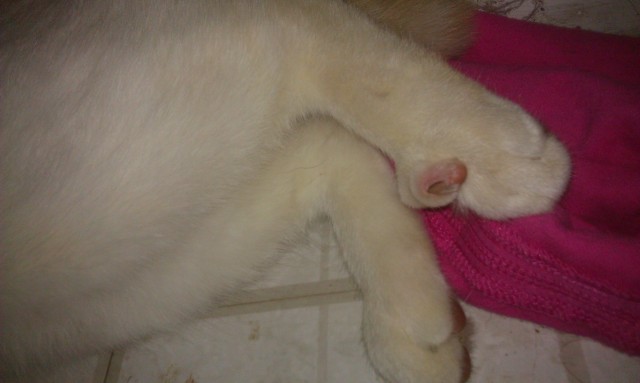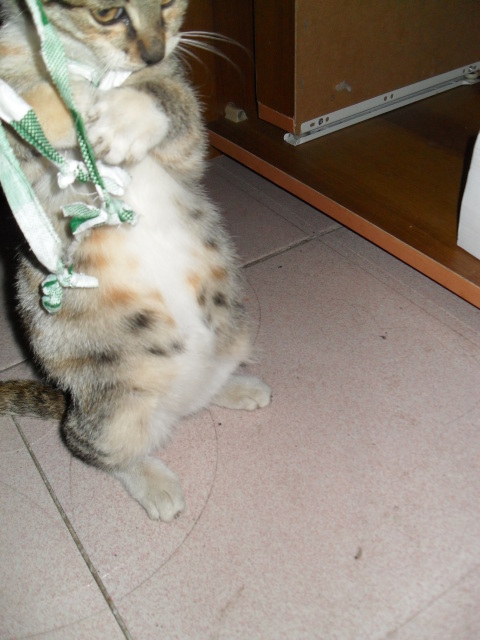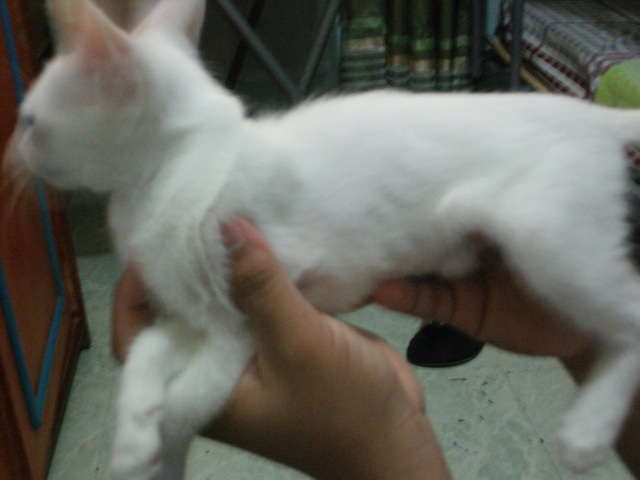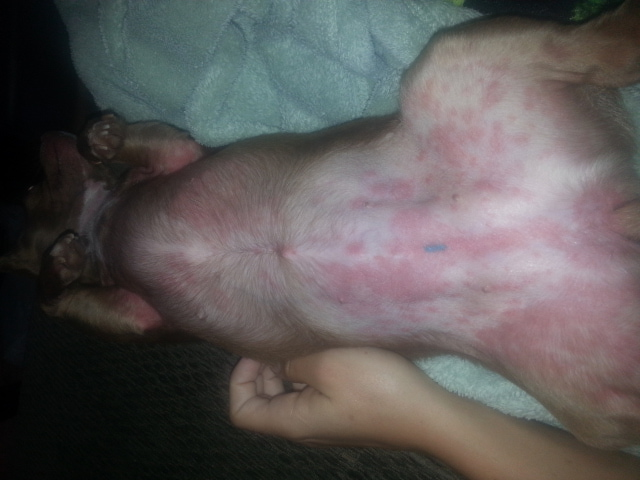QuestionHi..this past fall(I live in Minnesota), a friend stayed with us for two months. He brought with him a cat & a dog he found on the street in Mexico (the country). They lived outside, so they pooped & peeed all over our backyard. We had 4 cats then. 3 of them never went outside. We have 3 acres of land. The fourth cat was a stray..he was malnurished & must of been hit a lot because he winced every time we petted him. He was under a year old. We gained his trust & decided to keep him. So we got him shots & neutered. He stayed inside after dark. My husband worked outside a lot & this cat followed him around like a dog. He loved the outside, but we kept an eye on him. One of my other cats had a habit of licking the rear end of the other cats behind. I was very upset with my husband & his friend for putting my cats at risk of contracting some unknown disease & also contaminating our land. After this guy & his pets left, my cat that licks the behind, started losing weight & his meow was raspy & strained (he was around 12 years old). Our vet told us it was old age. Didn't take blood or anything like that. Six months later he died in my arms...he was skin & bones..couldn't meow..it was like he just wasted away. We did take him to the vet three weeks before he died, had a different vet, she said after blood tests it was his thyroid that caused this. I still think our uninvited pets have something to do with it. Could they have contaminated our ground & for how long will it take to get it out. I'm worried now because I only have two cats left, the stray cat..he's in good health. But I have a female cat thats about 10 years old, & is starting to show symptoms, like the other cat who died. The cat & dog from Mexico never had any shots what so ever. Am I letting my imagination take over?...just for the future...what kind of diseases could these animals bring with them? I'm sorry this is so long...I really appreciate your imput...sincerely, Deb Jackson
AnswerThyroid disease is not contagious. If left untreated, it progresses and causes muscle wasting, liver disease, high blood pressure and heart failure (below is more information). You need to take your other cat to the vet for blood testing as diabetes and kidney disease can also cause similar symptoms as thyroid disease in cats. Regardless of what the disease process, none of these three diseases are contagious and are related to aging.
As far as contagious diseases between cats...
feline leukemia and FIV
distemper (this is fatal--causing vomiting and diarrhea-- progresses very quickly and cats will die within a week if not treated, however, this is one thing we vaccinate for)
upper respiratory infection
intestinal parasites (however, these can also be gotten from fleas, rodents or other wildlife that can also contaminate your property)
===========================================
Feline hyperthyroidism
Affected Animals:
This is a common disease of older cats, with an average age of 13 years and a general range of four to 20 years. Cats of all breeds and both sexes can be affected.
Overview:
Feline hyperthyroidism is the most common hormonal abnormality and is a common disease of aging cats. Hyperthyroidism is a feline disorder affecting multiple body systems due to an overabundance of the thyroid hormone, which increases the metabolism. Because of this increase, the cat's body systems function at an accelerated rate that it may not be able to sustain. As a result, problems with the heart, gastrointestinal tract and kidneys may occur; weight loss, hyperactivity, and increased appetite are classic signs of the disease.
Routine laboratory tests will diagnose hyperthyroidism, which can be treated very successfully through medication, surgery, or radioactive iodine therapy. Cats with severe complications of the disease may not respond well to treatment.
Clinical Signs:
The clinical signs of hyperthyroidism demonstrate an overall increase in metabolism and involve multiple body systems. The majority of cases will show signs such as weight loss, polyphagia, hyperactivity, unkempt haircoat or alopecia, vomiting, diarrhea, polydipsia, polyuria, and aggression. Less than 10 percent of hyperthyroid cats will present with atypical signs such as poor appetite, anorexia, lethargy, and weakness. Common physical exam findings include an enlarged thyroid gland(s), cachexia, heart murmur, tachycardia, and hyperactive behavior.
Symptoms:
The common symptoms that most owners notice include weight loss, a voracious appetite, and increased activity level. Other common symptoms include vomiting, an unkempt haircoat, patches of hair loss, and increased water intake and urination.
Description:
Hyperthyroidism is the most common hormonal abnormality affecting cats. Most frequently afflicting cats eight years of age or older, it is a multisystemic metabolic disorder caused by high circulating levels of thyroid hormones. As a result, the body's systems begin working at an accelerated rate that can cause them to function abnormally. Most often, cats that develop this condition have hyperfunctional thyroid gland nodules. In rare cases, malignant thyroid tumors can lead to hyperthyroidism.
The elevated levels of thyroid hormones associated with hyperthyroidism cause many of the body's functions to run much faster than normal. Thyroid hormones affect the musculoskeletal, cardiovascular, gastrointestinal, liver, urinary, nervous, and behavioral systems. Common complications resulting from hyperthyroidism include heart muscle enlargement, high blood pressure, kidney function impairment, and intestinal problems.
Diagnosis:
Several other diseases, including chronic renal failure, liver disease, and cancer, can have similar symptoms as hyperthyroidism. A thorough history, physical exam, and routine laboratory testing will lead to the diagnosis of hyperthyroidism in the majority of cases. Routine testing includes a complete blood count, or CBC, a blood chemistry profile, urinalysis, and a test of the thyroid hormone concentration called a serum T4.
Cats with early signs of hyperthyroidism initially may show a thyroid hormone, or T4, level that is within the normal range, making diagnosis more difficult. Because hormone levels may fluctuate between normal and increased early in the course of the disease, it is important that cats showing early signs have their thyroid hormone levels evaluated after a period of one to two weeks. Sometimes more extensive thyroid tests, such as a free T4 or T3 suppression test, a thyrotropin-releasing hormone stimulation test, or a radionuclide thyroid scan may be required. Veterinarians in general practice may refer cats to a veterinary internist or veterinary teaching hospital for some of these procedures.
Prognosis:
The prognosis for uncomplicated hyperthyroidism is excellent. If the cat's physical condition is extremely poor or if another disease is present, the prognosis is not as good and will depend on the response to treatment. If cancer has caused the hyperthyroidism, thyroidectomy or radioiodine therapy may improve signs for some time but will not cure the disease.
Transmission or Cause:
The most common cause of hyperthyroidism is independently hyperfunctioning nodules of thyroid tissue. More rarely, malignant thyroid cancer also can cause hyperthyroidism. There are no known risk factors for the condition other than aging.
Treatment:
Treatment of hyperthyroidism usually is rewarding and extremely effective. The goal of treatment is to reduce the circulating levels of thyroid hormones. There are three options for treatment of hyperthyroidism: daily medications, surgical removal of thyroid tissue, or destruction of the abnormal thyroid tissue through radioiodine therapy. Of the three, only surgery and radioiodine treatments can result in a cure. Medications only can keep the disease under control while they are administered.
Before pursuing more aggressive treatment, many cats are treated with methimazole to bring the thyroid hormone concentration down into the normal range. Ruling out possible concurrent kidney failure is essential before surgery or permanent destruction by radioiodine, since permanent correction of hyperthyroidism can worsen renal disease.
The most commonly used antithyroid drug prescribed to cats is called methimazole. Most cats will need to be given methimazole twice daily for the best results. The drug is introduced at a low dose and then slowly increased to the most effective level for each individual cat. Mild side effects associated with methimazole include loss of appetite, vomiting, and lethargy.
Rare side effects include scratching to the point of causing lesions on the face and neck, a low platelet count, and bleeding disorders. These complications usually develop within the first few weeks of treatment and may require stopping the drug. Contact the veterinarian immediately if a cat on methimazole experiences any side effects.
Drug therapy typically requires frequent veterinary follow-ups for the first three months. Physical exams generally are scheduled every two to three weeks to assess improvements of hyperthyroidism clinical signs, especially of the heart, side effects of the drug, and improvement in the thyroid hormone concentration. Some owners may opt for long-term methimazole treatment if the cat responds well, or fails to develop side effects or resistance to the drug.
Thyroidectomy is the surgical removal of the thyroid gland or glands. If successful, this procedure will correct the hyperthyroidism permanently, unless thyroid cancer is present, or if only one gland is removed initially and the second gland continues or starts to hyperfunction. Antithyroid drugs sometimes are used preoperatively to reduce anesthetic and surgical risks and to rule out concurrent kidney failure.
Possible post-operative complications, rare if the procedure is performed by an experienced surgeon, include critically low blood-calcium levels due to removal or damage to the parathyroid glands, damage to the recurrent laryngeal nerve resulting in laryngeal paralysis, and permanent hypothyroidism requiring long-term thyroid hormone replacement.
Administered by injection, radioactive iodine treatment usually is successful in curing hyperthyroidism and causes the lowest incidence of side effects. However, it is not widely available because special equipment is required, along with strict adherence to radiation safety regulations. State and local radiation safety laws typically mandate in-hospital isolation for eight to 12 days without owner visitation.
Radioactive iodine destroys only functioning thyroid cells. Dormant thyroid cells that do not take up the radiation are then able to produce normal amounts of thyroid hormone at a later time. Very few cats, less than two to four percent, will require a second treatment or require thyroid hormone replacement therapy.
Prevention:
There are no known preventive measures other than monitoring cats for abnormal symptoms and taking them for yearly veterinary examinations.

 6 month old dog rear legs paralyzed
Question
Teddy
We adopted a lab/st.Bernard mix dog name
6 month old dog rear legs paralyzed
Question
Teddy
We adopted a lab/st.Bernard mix dog name
 Cat toe broken? dislocate? Urgent!
Question
Milos toe
First of all, I know that a v
Cat toe broken? dislocate? Urgent!
Question
Milos toe
First of all, I know that a v
 Feral cat with bloated stomach
Question
Cats stomach
Hello,
Id like some help with a
Feral cat with bloated stomach
Question
Cats stomach
Hello,
Id like some help with a
 Questions about kittens
Question
Chiyo
Good day, Ms. Eloise. I just beca
Questions about kittens
Question
Chiyo
Good day, Ms. Eloise. I just beca
 skin rash
Question
Chihuahua Rash chihuahua rash
My
skin rash
Question
Chihuahua Rash chihuahua rash
My